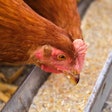Betaine has long been a known functional nutrient in broiler nutrition. In the past, it was mainly used in poultry feed as betaine anhydrous, extracted from sugar beets; but, now it is available as betaine hydrochloride, which is synthetically produced. Recent research has shown that nutritional properties of these products are equal, unveiling a cheaper, non-hygroscopic and year-round source of betaine for the feed industry. However, special care should be taken that the free-flowing properties of betaine hydrochloride are always ensured, since hygroscopicity may limit application in feed plants. With a strong focus on the crystallization process and the correct application of a free-flowing carrier, a non-hygroscopic betaine hydrochloride can be produced.
Absorption and metabolism
Betaine is absorbed via duodenum. Human studies showed rapid absorption and distribution with a peak increase in serum one to two hours post food intake. Weigand and Kirchgessner (1981) reported that betaine is absorbed in the gastrointestinal tract, where up to three-fourths of it could remain at the intracellular level. Intracellular accumulation takes place via active (Na+ or Cl-) and passive (Na+) transport systems.
Betaine is eliminated by metabolism, not by excretion, and catabolized via a series of enzymatic reactions that occur in the mitochondria of liver and kidney cells. The principal physiologic role of betaine is to act as an osmolyte and as a methyl donor. As an osmolyte, betaine increases intracellular water retention and, therefore, protects intracellular enzymes against osmotic-induced inactivation. As a methyl donor, betaine participates in the methionine cycle (mainly in the liver) and can be further used in transmethylation reactions (Figure 1) for synthesis of essential substances like carnitine and creatine (Kidd et al., 1997).
Biological equivalence
Betaine is a zwitterion metabolite, also known as trimethylglycine. It was first discovered in sugar beets, but it is also present in other plants, animals and seafood. However, sugar beets contain exceptionally high levels of betaine, which accumulate as a condensed soluble (approximately 116,000 mg/kg; Eklund et al., 2005). Currently betaine is available in several purified forms (anhydrous, monophosphate and hydrochloride betaine).
Questions have been raised asking if osmoregulatory properties of betaine hydrochloride are similar to those of betaine anhydrous. To study this question, an in vitro trial was set up to mimic gastric passage. De Krimpe (University of Ghent, 2010; unpublished) evaluated the biological equivalence of different betaine sources (monohydrate and anhydrous, produced by extraction, versus betaine hydrochloride and anhydrous, produced by chemical synthesis). The products were dissolved in a water and hydrochloride solution with pH 2.3 (gastric conditions) and then analyzed using high-performance liquid chromatography – electrospray ionization mass spectrometric and direct mass spectrometric analysis.
Results showed that irrespective of the ionic form and production method (natural extraction versus chemical synthesis), different sources of betaine gave the same analytical results (same m/z retention time pairs). Therefore, no difference in biological activity or osmoregulatory function should be expected. If, after gastric passage, both molecules are identical, no differences between betaine hydrochloride and betaine anhydrous as an effective feed additive could reasonably be expected.
Betaine in poultry production
Elklund et al., (2005) and Ratriyanto et al., (2009) carried out comprehensive reviews of the effects of feeding betaine to poultry. Results of nutrient digestibility, animal performance, metabolism and improvement in carcass leanness were reviewed and reported. These peer-reviewed papers illustrated the benefits of betaine as a feed additive capable of improving animal performance and slaughter characteristics. Studies included in these reviews were conducted with a particular scientific thought, and animal responses were the result of one of the betaine’s modes of action. These were both influenced by the concentration of other methyl donors in the diet and the presence of either an osmotic or metabolic stress.
Methyl donor and sparing effect
Dietary supplementation of betaine may reduce the requirement of other methyl donors, such as methionine and choline (Siljander-Rasi et al., 2003). However, this theoretical application must be subjected to considerable analysis before practical implementation (Matthews et al., 2001; Zhan et al., 2006). This sparing effect of methionine and choline has been thoroughly investigated in poultry. Pesti et al., (1979) showed that the dietary addition of betaine and methionine can replace each other in broiler chicks. Florou-Paneri et al., (1997) showed that between 30 percent and 80 percent of the supplemental methionine can be substituted by betaine without negative effects on performance. A more conservative replacement approach was evaluated in popular magazines by Lensing and Van der Klis (2007) and Cresswell (2010). Both experiments studied the bioequivalency between betaine and choline/methionine in broilers diets; whereas choline was fully replaced, methionine decreased by 25 percent to 30 percent of daily requirements. Within this range of replacement, no differences in broilers performance were observed.
Practical studies
In line with the results found by Cresswell, Dr. Rama Rao (2011, unpublished) performed a trial at IPME in Pune, India, and showed improved performance and carcass yield for all treatments. Moreover, this trial presented an insight in different application strategies. Two thousand Cobb broiler birds were divided in four treatments with two replicates each. The control diets were typical corn-soy diets containing 2,000 ppm, 1,500 ppm and 1,500 ppm added choline chloride (75 percent), as well as 0.61 percent, 0.58 percent and 0.45 percent total methionine for starter, grower and finisher diets, respectively. Best economical results were achieved with on-top addition of betaine (treatment two); an investment of $0.002/kg feed resulted in 7 percent savings in production costs of dressed weight. Replacement of certain levels of choline and methionine showed good economical results. Treatment three (strong replacement of choline and methionine) showed that with lower feeding costs, a small improvement in production could be achieved. Treatment four (careful replacement of choline and methionine) was a safe strategy with equal costs of the diet, but a good return on investment. Results of this trial are summarized in Figure 2.
Osmoprotective properties
The regulation of cellular hydration state, and therefore cell volume, is important for maintenance of cell function and several metabolic pathways, that is, protein turnover and amino acid carbohydrate. Cells try to adapt to external osmotic stress by accumulating inorganic ions (Na+, K+, Cl-) and organic osmolytes (methylated amines and certain amino acids). However, the increase in intracellular concentrations of inorganic ions is limited, due to their destabilizing effect on protein structure and enzyme function. On the other hand, organic osmolytes can reach high intracellular concentrations without disturbing cellular functions. Betaine is considered the most effective organic osmolyte. It accumulates in gastrointestinal tract cells regulating water flux across the intestinal epithelium. Betaine had also shown to inhibit cellular apoptosis and to reduce energy expenditure for gastrointestinal tract cells.
Overcoming heat stress
Several scientific publications have shown proof that betaine anhydrate can be used to overcome heat stress. Attia et al., (2009) showed that the impact of severe heat stress could partially be overcome by adding betaine to the diet in slow-growing broilers. Adding 1 kilogram betaine to the diet improved weight gain and feed conversion, compared to negative control treatment. More importantly, rectal temperature decreased (43.2 C versus 41.9 C) compared to negative control. Panting, a mechanism of heavy breathing to lose heat via evaporation, was also reduced from 78.3 breaths/minute to 63.9 breaths/minute.
Haldar et al., (2011) presented a study under more practical conditions showing that under (milder) heat stress conditions (31 C, ±85 percent relative humidity) in conventional broilers, the same effects could be expected. More importantly, they showed that these results could be obtained using betaine hydrochloride and, thereby, gave practical proof that betaine hydrochloride has similar osmoregulatory properties as an anhydrous source. Heat stress started at day 14. In this trial, a positive control and negative control were used, whereby the negative control treatment was lowered in methionine (850 gr/MT), added choline was removed and energy was reduced (-50 kcal ME). Betaine hydrochloride was added at 1.3 kg/MT and 2.0 kg/MT, whereby the same replacement of methionine, choline and energy as in negative control was used. Body weight of broilers at 38 days increased from 1.80 kg (control) to 1.84 kg and 1.86 kg for birds fed 1.3 kg/MT and 2.0 kg/MT of betaine hydrochloride, respectively. Feed conversion improved from 1.67 in positive control to 1.63 (1.3 kg betaine HCl) and 1.62 (2.0 kg betaine HCl). Figures 3 and 4 show the details of rectal temperature and panting, clearly indicating that, during heat stress, betaine hydrochloride alleviates these negative effects.
Conclusions
Betaine has been used in broiler nutrition for many years. Scientific proof has shown that betaine improves production performance, replaces other methyl group donors such as choline and methionine, assists birds during heat stress and improves slaughter characteristics. Many of these published articles were not clear on the source of betaine used (natural, extracted betaine anhydrous or synthetic betaine hydrochloride), and concern has been raised if betaine hydrochloride would be as effective in osmoregulation as betaine anhydrous from sugar beet extraction. The data presented above clearly show that if a proper crystalline betaine hydrochloride is used, its molecular structure is similar after gastric passage as betaine anhydrous.
Care should be taken that the product has good free-flowing properties and that it is non-hygroscopic. Practical application trials with birds fed betaine during heat stress clearly showed the expected improvement and therewith the mode of action of betaine hydrochloride as an osmoprotectant.
This new form of betaine (betaine hydrochloride) has increased year-round availability since production is independent of sugar beet production. Additionally, as the cost of betaine hydrochloride is generally lower than that of betaine anhydrous, the applications of betaine in broiler nutrition should be reconsidered by feed producers.















